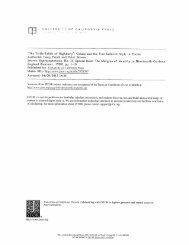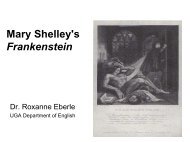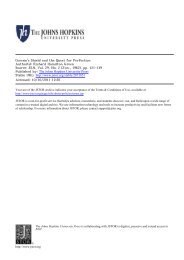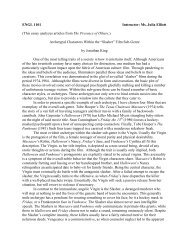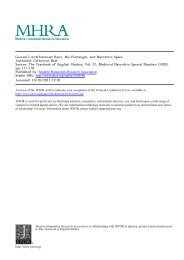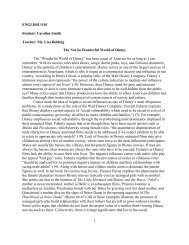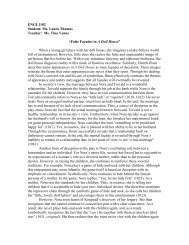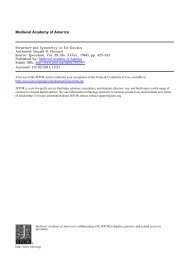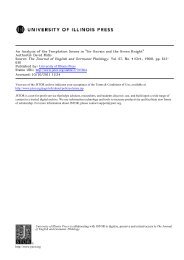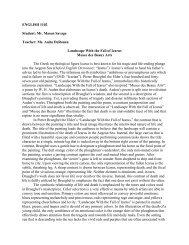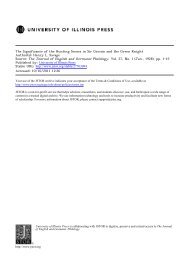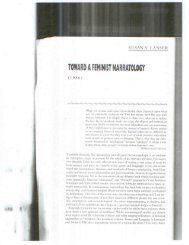English 1102 Instructor: Ms. Angela Mitchell Life's Not A Paragraph ...
English 1102 Instructor: Ms. Angela Mitchell Life's Not A Paragraph ...
English 1102 Instructor: Ms. Angela Mitchell Life's Not A Paragraph ...
You also want an ePaper? Increase the reach of your titles
YUMPU automatically turns print PDFs into web optimized ePapers that Google loves.
<strong>English</strong> <strong>1102</strong> <strong>Instructor</strong>: <strong>Ms</strong>. <strong>Angela</strong> <strong>Mitchell</strong><br />
Life’s <strong>Not</strong> A <strong>Paragraph</strong><br />
by<br />
Bonnie Sillay<br />
Throughout his poetry, E. E. Cummings seduces readers deep into a thicket of scrambled<br />
words, missing punctuation, and unconventional structure. Within Cummings’s poetic bramble,<br />
ambiguity leads the reader through what seems at first a confusing and winding maze. However,<br />
this confusion actually transforms into a path that leads the reader to the center of the thicket<br />
where Cummings’s message lies: one should never allow one’s experience to be limited by<br />
reason and rationality. In order to communicate his belief that emotional experience should<br />
triumph over reason, Cummings employs odd juxtapositions, outlandish metaphors, and<br />
inversions of traditional grammatical structures that reveal the “illogic” of reason. By breaking<br />
down the formal boundaries of his poetic structures, Cummings urges his readers to question<br />
boundaries of any kind. Indeed, in the same manner Cummings’s literary style appears to be<br />
uncontrolled; many of his poems, such as “since feeling is first” and “as freedom is a<br />
breakfastfood,” in turn suggest that emotion provides the compositional fabric for our experience<br />
of life, and therefore, emotion itself should never be defined or controlled.<br />
In “since feeling is first,” Cummings urges his reader to reject any attempts to control<br />
emotion by using <strong>English</strong> grammar as one example of the restrictive conventions present in<br />
society. By stating that “since feeling is first / who pays any attention / to the syntax of things,”<br />
Cummings suggests that emotion should not be forced to fit into some preconceived framework<br />
or mold (1-3). He carries this message throughout the poem by juxtaposing images of the<br />
abstract and the concrete–images of emotion and images of <strong>English</strong> grammar. The abstract<br />
nature of emotion and the undeniably concrete nature of <strong>English</strong> grammar reveal the absurdity of<br />
restricting emotion. Cummings’s word choice enhances the depictions of his intentionally<br />
strange juxtapositions, with the poet often using grammatical terms that suggest some sort of<br />
regulation or confinement. For example, the line, “and death I think is no parenthesis,” implies<br />
confinement (16). By suggesting that parentheses trap the words they surround, Cummings<br />
warns the reader to not let death trap one’s life or emotions. The poet does not want our<br />
emotions to be confined by reason. Referring to emotion, Cummings uses words such as “kisses”<br />
and “blood” (8, 7). These words are somewhat subjective and are almost impossible to define<br />
accurately or to confine–kisses mean different things to different people, blood flows through the<br />
body freely and continually. Cummings’s word choice ultimately paints language as restrictive<br />
and emotion as a flowing and powerful force.<br />
Aside from poetic diction, Cummings also rejects conventions in the structure of the<br />
poem. Instead of the traditional poetic structure that seeks resolution in the final stanzas of a<br />
poem, Cummings opens his poem by stating his primary message: “since feeling is first / who<br />
pays any attention to the syntax of things” (1-2). Here, Cummings urges the reader to realize that<br />
order and structure come secondary to emotion. How can emotion be bottled in sentences and<br />
interrupted by commas, colons, and spaces? To Cummings, emotion is a never-ending run-on<br />
sentence that should not be diagramed or dissected: emotion should never be intellectualized.<br />
Cummings also emphasizes his belief that emotion should not be intellectualized in the<br />
third stanza of “since feeling is first,” noting, “my blood approves, / and kisses are a better fate /<br />
than wisdom” (7-9). Here, Cummings wants the reader to go with his or her gut feeling, to revel
in what he or she feels during a fleeting moment, such as a kiss. He continues his refusal to<br />
intellectualize emotion by stating, “the best gesture of my brain is less than / your eyelids’<br />
flutter” (11-12). Cummings wants the reader to focus on a pure emotive response, in this case,<br />
the blush of a cheek or the flutter of an eyelash, to concentrate on the emotional, not the logical–<br />
words, instead of punctuation and spaces. Cummings’s use of two grammatical terms in the last<br />
line, “for life’s not a paragraph / and death I think is no parenthesis,” once again alludes to<br />
attempts to format lives and feelings into nice, responsible segments that smoothly run together<br />
(15-16). Attempts to control, rather than feel, are rejected throughout Cummings’s entire poem.<br />
In “since feeling is first,” he suggests that life and emotions do not have to fit into a certain<br />
space. For Cummings, life does not have to be an introduction, followed by well thought-out<br />
paragraphs tied together with smooth transitions followed by a logical conclusion. Emotion<br />
should be limitless, free from any restrictions or rules.<br />
Cummings continues the idea of emotion as limitless in “as freedom is a breakfastfood”<br />
as he compares love to an endless sky. Although he weaves his belief in the power of emotion<br />
throughout both poems in slightly different ways, the underlying theme is very similar: emotion<br />
is always best when it is uncontrolled and indefinable. Cummings employs inversions to portray<br />
this message. One might suggest that Cummings uses the inversion of grammar in “since feeling<br />
is first” and the inversion of reason in “as freedom is a breakfastfood” to depict the message that<br />
emotion should not be intellectualized. While “since feeling is first” portrays emotion as being<br />
unable to be controlled, ordered, or analyzed, “as freedom is a breakfastfood” suggests the<br />
difficulty of defining emotion. The poem is also full of outlandish metaphors that are deliberately<br />
far-fetched such as, “freedom is a breakfastfood” or “time is a tree” (1, 26). These metaphors are<br />
somewhat arbitrary, and Cummings does not attempt to make profound statements on time or<br />
freedom, but rejects the definite “is” in these images. Cummings suggests that there is no right or<br />
wrong definition of anything. Freedom and time are subjective, and attempts at definition are<br />
ridiculous. Cummings also employs inversions of nature, such as “robins never welcome spring”<br />
and “water most encourage flame,” to underscore emotion’s ability to defy reason (16, 7).<br />
Cummings uses these inversions to suggest the arbitrariness of words or, as he puts it in “since<br />
feeling is first,” the syntax of things” (3).<br />
By the close of “freedom is a breakfastfood,” Cummings compares love to the sky: “but<br />
love is the sky” (27). The final structure of the poem helps Cummings portray love as limitless;<br />
although, most of the poem has a very rambling mind-set, Cummings shifts tones at the end of<br />
the poem with the use of “but.” By prefacing the final metaphor, “love is the sky,” with “but,”<br />
Cummings not only separates it from the rest of the poem, but also subtly validates the<br />
statement, implying that the final metaphor is the only accurate comparison in the whole poem.<br />
In order to reach this final conclusion, however, Cummings has taken his readers on a long and<br />
often ambiguous journey.<br />
Nevertheless, this confusion has been deliberate: Cummings wants his readers to follow<br />
him through the winding thicket because he believes the path of the straight and narrow limits<br />
the possibilities of experience. Through the unconventionality of his poetic structures,<br />
Cummings urges his readers to question order and tradition. He wants his readers to realize that<br />
reason and rationality are always secondary to emotion, that emotional experience is a freeflowing<br />
force that should not be constrained. Cummings’s poetry suggests that in order to get at<br />
the true essence of something, one must look past the commonsensical definition, and not be<br />
limited by “the syntax of things.”



